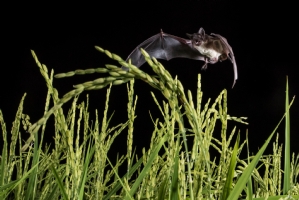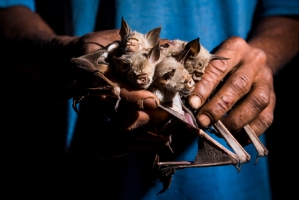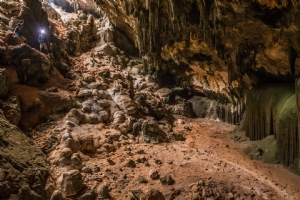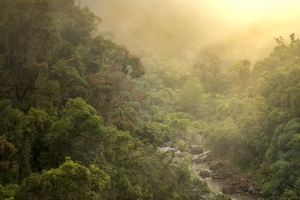Galería Beca bienal MontPhoto 2018
Los murciélagos que disminuyen la deforestación en Madagascar

AUTOR/ES
Joan de la Malla / Adrià López-Baucells
Joan de la Malla: Biólogo especializado en organismos y sistemas y fotógrafo freelance especializado en temáticas de conservación, naturaleza y medio ambiente. Actualmente centro mis esfuerzos en temáticas conservacionistas, trabajando con diversas entidades internacionales. Publico regularmente mis imágenes en medios de ámbito nacional e internacional de prestigio y mis imágenes han aparecido en diversas exposiciones, nacionales e internacionales, tanto individuales como colectivas. Recientemente he acompañado en dos ocasiones al Global Change and Conservation para reportar su trabajo de investigación para la conservación en Madagascar. Paralelamente a mi labor fotográfica realizo también una labor docente impartiendo formación sobre fotografía y fotografía científica en diversas universidades.
Adrià López-Baucells: Biólogo especialista en quirópteros, empecé a colaborar con el Museo de Granollers en 2005 como investigador asociado. Desde entonces he llevado a cabo proyectos de conservación en Australia, Colombia, Brazil, Inglaterra, España, y más recientemente Madagascar y Kenya. Actualmente estoy terminando mis estudios doctorales en plena selva amazónica. Desde sus inicios, mi carrera profesional como investigador se complementa profundamente en la comunicación científica a través de reportajes fotográficos (BBC, Biosphere o Swara), exposiciones interactivas y actividades educacionales.
INFORME COMPLETO
Los murciélagos que pueden ayudar a salvar los bosques de Madagascar
El objetivo de este proyecto es explicar la relación entre humanos y murciélagos en Madagascar y arrojar luz sobre lo necesaria y mal entendida que es su coexistencia y la conveniencia de su colaboración por el bien de ambos.
Madagascar es un paradigma de biodiversidad, pero actualmente sufre una intensa deforestación debido a la agricultura de tumba, roza y quema que es comúnmente practicada por los agricultores locales en la isla. El riesgo de pérdida de biodiversidad en ecosistemas de alto valor ecológico (que albergan una gran proporción de especies endémicas) es de gran importancia. A su vez, el país enfrenta una gran pobreza y muestra un gran crecimiento demográfico que lleva inevitablemente a una mayor necesidad de comprender y gestionar las crecientes interacciones entre humanos y fauna salvaje. Todo esto constituye el marco en que esta historia sucede.
Los murciélagos insectívoros son vistos con recelo y desconfianza por la mayoría de habitantes de Madagascar. En el sur, poblaciones cazadoras-recolectoras los consumen como fuente ocasional de proteínas y los cazan a la salida de sus cuevas. Sin embargo, a la mayor parte del resto de la población les parecen animales indeseables y rodeados de supersticiones.
Un estudio recientemente publicado en 2018 mostró que varias especies de murciélagos insectívoros se alimentan de las plagas que a veces devastan los campos de arroz en Madagascar. Estas plagas tienen un impacto importante en el rendimiento de los cultivos, diezmándolos hasta en un 70%. El control biológico ejercido por los murciélagos tiene un efecto significativo: aumenta la productividad de los cultivos y asegura la alimentación de la población local, al tiempo que reduce la presión sobre el ecosistema al evitar la deforestación para la creación de nuevas tierras agrícolas. Sin embargo, la población local no es conocedora de todo esto, y a menudo expulsan o exterminan a los murciélagos sin darse cuenta de los inmensos beneficios que proporcionan.
Por otra parte, el guano de estos murciélagos se explota comercialmente en algunas cuevas donde éstos viven. A veces, la mala praxis en la recolección del guano molesta a grandes colonias que, en respuesta, abandonan la zona y con ello desaparece el control biológico que ejercían. También existe una modesta recolección de guano por parte de las comunidades locales que se realiza de una forma más sostenible. Esta práctica es beneficiosa en algunas áreas donde utilizan este guano como fertilizante en sus propios cultivos. Parte de esta recolección local sucede en las propias aldeas ya que los murciélagos se refugian en los techos de metal (nunca en los techos tradicionales) de las construcciones modernas que poco a poco van proliferando en la isla. Esto crea una situación en la que los lugareños pueden recolectar y usar el guano fácilmente pero, a su vez, también implica indeseables riesgos para la salud y el bienestar tanto de humanos como de murciélagos.
Paralelamente a esta historia, los murciélagos frugívoros de la isla son uno de los principales responsables de la diseminación de semillas, lo que contribuye en gran medida a la expansión de los escasos bosques que quedan de la isla. Estos murciélagos, endémicos y amenazados, son cazados extensivamente con diversas técnicas en varios lugares de la isla. Incluso existen empresas que, pese a estar amenazados, los cazan comercialmente. A diferencia de lo que sucede con los murciélagos insectívoros, los murciélagos frugívoros son ampliamente consumidos en el país: en algunas regiones se los considera un manjar, mientras que en otras se comen por pura subsistencia. Sin embargo, el guano de estas especies es muy valioso y en algunos lugares de la isla es explotado comercialmente e incluso exportado. Esto pone a estas especies en valor y hace que exista voluntad para conservarlas por su interés económico, haciendo de la caza una actividad menos deseable.
Todas estas complicadas relaciones, sumadas a la falta de comprensión de estos animales y a la existencia de numerosos tabúes y mitos locales, crean una compleja realidad que, si se trata correctamente, puede poner en valor el papel de los murciélagos y ayudar a su conservación. Y no solo eso, sino que también puede ayudar a las comunidades locales a ejercer una explotación sostenible de los diversos servicios ecosistémicos que los murciélagos proporcionan.
Normas de uso del web | Avíso legal | Política de privacidad | Política de cookies | Cambiar preferencias de cookies
Administración | Diseño web: ATMultimedia.com




























